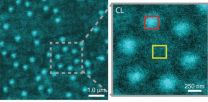Genome-wide DNA study shows lasting impact of malnutrition in early pregnancy
2015-05-14
(Press-News.org) May 14, 2015 -- Researchers at Columbia University's Mailman School of Public Health and Leiden University in the Netherlands found that children whose mothers were malnourished at famine levels during the first 10 weeks of pregnancy had changes in DNA methylation known to suppress genes involved in growth, development, and metabolism documented at age 59. This is the first study to look at prenatal nutrition and genome-wide DNA patterns in adults exposed to severe under-nutrition at different periods of gestation. Findings are published in the International Journal of Epidemiology.
The study evaluated how famine exposure -- defined as 900 calories daily or less -- during the Dutch Hunger Winter of 1944-1945 affected genome-wide DNA methylation levels. The researchers also studied the impact of short-term exposure, pre-conception and post-conception. The study used blood samples of 422 individuals exposed to the famine at any time during gestation and 463 controls without prenatal famine exposure.
The authors examined individuals born between February 1945 and March 1946 whose mothers were exposed to the famine during or immediately preceding pregnancy, individuals conceived between March and May 1945 at the time of extreme famine, and controls born in the same institutions whose mothers did not experience famine while pregnant as well as sibling controls who were also not exposed to famine in pregnancy.
The findings show associations between famine exposure during weeks 1-10 of gestation and DNA changes, but not later in pregnancy. DNA methylation changes were also seen among individuals conceived at the height of the famine between March and May 1945 who were not exposed to all 10 weeks of early gestation.
"The first ten weeks of gestation is a uniquely sensitive period when the blood methylome -- or whole-genome DNA methylation -- is especially sensitive to the prenatal environment," said L.H. Lumey, MD, PhD, associate professor of Epidemiology at the Mailman School of Public Health, and last author. "This is the period when a woman may not even be aware that she is pregnant."
Earlier studies in other populations in the Netherlands led by Dr. Lumey examined the long-term impact of famine exposure and identified early gestation as the most critically sensitive period. Their work among over 45,000 military recruits revealed that famine exposure in the first pregnancy trimester was associated with a 10-percent increase in mortality at age 63 years.
Ongoing Research
"Further analysis of health outcomes among men and women with famine exposure is now needed. We are therefore looking if DNA-methylation can make a difference for obesity and diabetes risk in this population," said Lumey. "We are also interested in sex-specific effects, but for these questions larger studies may be needed."
INFORMATION:
Co-authors are Elmar W. Tobi, Roderick C. Slieker, H. Eka D. Suchiman, P. Eline Slagboom, Erik W. van Zwet, and Bastiaan T. Heijmans of Leiden University Medical Center, and Aryeh D. Stein, Emory University Rollins School of Public Health. DNA analyses were performed by Tobi and Heijmans and their colleagues from the Molecular Epidemiology group at Leiden University Medical Center.
The study was supported by the National Institutes of Health grants AG042190 and HL067914. There were no reported conflicts of interest.
About Columbia University's Mailman School of Public Health
Founded in 1922, Columbia University's Mailman School of Public Health pursues an agenda of research, education, and service to address the critical and complex public health issues affecting New Yorkers, the nation and the world. The Mailman School is the third largest recipient of NIH grants among schools of public health. Its over 450 multi-disciplinary faculty members work in more than 100 countries around the world, addressing such issues as preventing infectious and chronic diseases, environmental health, maternal and child health, health policy, climate change & health, and public health preparedness. It is a leader in public health education with over 1,300 graduate students from more than 40 nations pursuing a variety of master's and doctoral degree programs. The Mailman School is also home to numerous world-renowned research centers including ICAP (formerly the International Center for AIDS Care and Treatment Programs) and the Center for Infection and Immunity. For more information, please visit http://www.mailman.columbia.edu.
ELSE PRESS RELEASES FROM THIS DATE:
2015-05-14
Army scientists working to support the Ebola virus outbreak response in West Africa have established the first genomic surveillance capability in Liberia, enabling them to monitor genetic changes in the virus within one week of sample collection. An article describing their work was recently published ahead of print in the online edition of Emerging Infectious Diseases.
In the paper, the team offers a concise evaluation of the potential impact of the evolution of Ebola virus Makona, the strain responsible for the current outbreak, based on genome reconstruction of 25 ...
2015-05-14
LAWRENCE -- For centuries, people have imagined the possibility of life on Mars. But long-held dreams that Martians could be invaders of Earth, or little green men, or civilized superbeings, all have been undercut by missions to our neighboring planet that have, so far, uncovered no life at all.
Yet visits to the Red Planet by unmanned probes from NASA and the European Space Agency have found evidence that a prime condition for life once may have existed: water.
"There has been a tremendous amount of very exciting findings this year that Mars once contained actively ...
2015-05-14
The Aqua satellite's MODIS (Moderate Resolution Imaging Spectroradiometer) instrument took this image of the fires in Siberia. The top image shows the full sized false color image of the area highlighting the burn scars from previous fires.
The sliding "before and after" image shows the real and false color images side-by-side for comparison. The left side shows current fires burning denoted by the red spots. These spots show areas where the thermal detectors on the MODIS instrument recognized temperatures higher than background. When accompanied by plumes of smoke, ...
2015-05-14
Soft matter encompasses a broad swath of materials, including liquids, polymers, gels, foam and - most importantly - biomolecules. At the heart of soft materials, governing their overall properties and capabilities, are the interactions of nano-sized components. Observing the dynamics behind these interactions is critical to understanding key biological processes, such as protein crystallization and metabolism, and could help accelerate the development of important new technologies, such as artificial photosynthesis or high-efficiency photovoltaic cells. Observing these ...
2015-05-14
DNA damage caused by smoking can be detected in cheek swabs, finds research published today in JAMA Oncology. The study provides evidence that smoking induces a general cancer program that is also present in cancers which aren't usually associated with it - including breast and gynaecological cancers.
The research team, led by Professor Martin Widschwendter, Head of the Department of Women's Cancer at the UCL Institute for Women's Health and Dr Andrew Teschendorff (UCL Cancer Institute) looked at epigenetic alterations - changes to the DNA that switch genes on and off. ...
2015-05-14
May 14, 2015 - For medical practices, having more unique doctors on staff and having doctors see more patients doesn't necessarily lead to improved patient outcomes--and in fact, may have the opposite effect, according to a brief report in the June issue of Medical Care. The journal is published by Wolters Kluwer.
The study shows that high blood pressure (BP) is less likely to normalize during times when the number of unique doctors on staff is higher and more patients are seen, suggesting that "[W]hen practices are busier, BP care may suffer," writes Nancy R. Kressin, ...
2015-05-14
Automated analysis of the vital signs commonly monitored in patients being transported to trauma centers could significantly improve the ability to diagnose those with life-threatening bleeding before they arrive at the hospital, potentially saving their lives. In the May issue of the journal Shock, a research team from Massachusetts General Hospital (MGH), the U.S. Army, air ambulance service Boston MedFlight, and two other Boston trauma centers report successful field testing of a system that simultaneously analyzed blood pressure, heart rate, and breathing patterns during ...
2015-05-14
Scientists have made an important step towards understanding how volcanic eruptions happen, after identifying a previously unrecognised potential trigger.
An international team of researchers from the University of Liverpool, Monash University and the University of Newcastle (Australia) think their findings could lead to new ways of interpreting signs of volcanic unrest measured by satellites and surface observations.
Dr Janine Kavanagh, from the University of Liverpool's School of Environmental Sciences and lead author of the research paper, said: "Understanding the ...
2015-05-14
Led by Georgia State University, researchers have developed the first robust and noninvasive detection of early stage liver cancer and liver metastases, in addition to other liver diseases, such as cirrhosis and liver fibrosis.
Their findings were published Wednesday (May 13) in Proceedings of the National Academy of Sciences.
More than 700,000 people are diagnosed with liver cancer each year. It is the leading cause of cancer deaths worldwide, accounting for more than 600,000 deaths annually, according to the American Cancer Society. The rate of liver cancer in the ...
2015-05-14
The combination of a cholesterol-lowering drug, Bezafibrate, and a contraceptive steroid, Medroxyprogesterone Acetate, could be an effective, non-toxic treatment for a range of cancers, researchers at the University of Birmingham have found.
The findings published in the journal Cancer Research show that the drugs kill cancer cells in a completely new way.
Early stage clinical trials of the drugs in elderly patients with acute myeloid leukaemia (AML) have shown promising results, with survival three months longer on average than standard palliative care. The combination, ...
LAST 30 PRESS RELEASES:
[Press-News.org] Genome-wide DNA study shows lasting impact of malnutrition in early pregnancy


